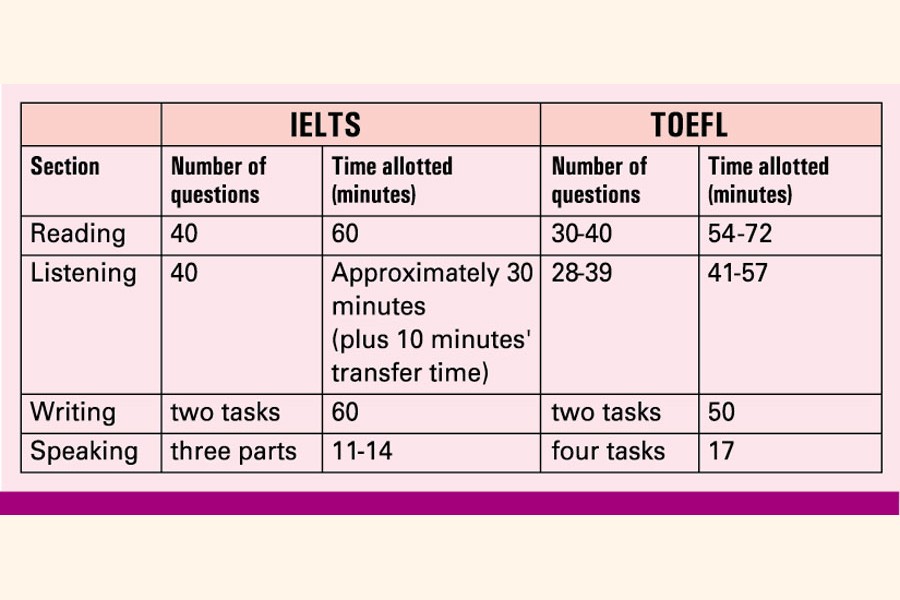Bangladeshi students have been keen on pursuing education beyond borders to experience top-quality education, expand opportunities, or simply broaden their insights. There are internationally accepted standardised tests students take to get accepted by their dream universities. This article highlights how best to prepare for two popular tests -- IELTS and TOEFL.
Exam pattern of English proficiency tests: IELTS (International English Language Testing System) and TOEFL (Test of English as a Foreign Language) are the two most popular English proficiency tests that reflect one's English abilities in academic and practical settings. Both tests consist of four sections -- Reading, Listening, Speaking, and Writing. The number of questions and the time allotted for each section are given in the table.
It is worth mentioning that the IELTS has two versions -- IELTS Academic and IELTS General training. The scope of this article is confined to IELTS Academic since students applying to universities are expected to take this version of the IELTS.
Reading: The reading sections of IELTS and TOEFL test whether an examinee can recognise salient ideas of each passage, identify details, and analyse the writer's perspectives on the given issues.
"This section contains detailed comprehension passages with MCQs, gap-filling activities, and similar questions following it. Solving past papers will benefit students to pinpoint the answers accurately," says Kazi Ahmed Hossain Pronit, who has been assisting students of different backgrounds in preparing for their English proficiency tests for more than three years. "Time management is crucial here since the passages are lengthy and require unwavering focus to comprehend," he points out. A way of saving time is to look at the questions following the passage at first and then read the passage so we know the exact information to search for.
Listening: Opting for online tests identical to the original helps one get accustomed to the format.
"I found numerous listening tests on YouTube that helped me comprehend the question types. No recordings are repeated in the original test which makes it important for a learner not to pause the video and listen for details in one go while practicing," says Reazus Salehin who scored 8.5 in the IELTS earlier this year and set off to pursue a bachelor's degree in Economics in the University of Adelaide. If someone finds it difficult to understand foreign accent at first, they can gradually get accustomed to it by watching English movies and the news.
Speaking: In the TOEFL, some tasks involve speaking about a given topic for a specified period after reading a passage and listening to a recording about it. The IELTS speaking not only includes conversations about familiar topics (family and interests etc.) but also in-depth discussion regarding a narrative. According to Reazus Salehin, "It can be daunting to remain calm in front of an examiner who is a native speaker, especially when we know we are being tested on our speaking abilities. However, one can overcome this fear by practicing with friends or in front of a mirror."
Writing: The TOEFL writing has two tasks -- Independent Writing and Integrated Writing. For the former, examinees have to write on a given topic expressing their ideas coherently and bolstering them with examples. In contrast, examinees are given a short recording and a short passage in the Integrated Writing from which they have to summarise and compare the information.
The IELTS writing has two tasks as well. Writing task 1 involves succinctly describing key aspects of a given visualisation such as a graph, chart, table, or sometimes a map while Task 2 involves argumentative writing in which students have to argue for or against a topic using a formal writing style. Examinees are scored depending on the 'cohesion', 'coherence', 'task response', and 'lexical resource. "To improve these aspects, once the basics of grammar are covered, repetitive practice using mock papers will enhance one's performance in the writing section. I had personally utilised this approach before my test and afterward with my students as well," notes Kazi Ahmed highlighting the importance of practicing.
Examinees can utilise online resources such as Write To Top, Adam's English Lessons, and E2 IELTS on YouTube to learn ways of adapting to the creative freedom offered by this section. Additionally, IELTS examinees found the website ieltsadvantage.com remarkably helpful as it contains sample questions for every question type section-wise.
Pro-tips: As for Speaking, mentally noting the points to converse about before starting to speak can help one boost the coherence and cohesion during the speeches.
Again, the test format in TOEFL is almost always an Internet-based Test (TOEFL iBT), making the Paper-based Test (TOEFL pBT) the less chosen alternative. In contrast, IELTS examination centres in Bangladesh offer both paper-based and computer-based tests-- either way, the students have to answer the same questions but choosing one's preferred format adds to one's advantage.
Securing a high score: Being acclimated with the test format and getting adequate practice for each section are key to securing a higher score. The IELTS band ranges from 0 to 9 where examinees obtaining 9 are 'expert users' who have fully operational command of the language. All four sections are graded individually and then averaged to obtain the final band score. The TOEFL iBT is scored on a scale of 0 to 120 where each of the four sections receives a scaled score from 0 to 30.
One's chances of performing better significantly increase when one truly aims to grasp the intricacies of the language with all its idiosyncrasies. Learners should have the mindset that English is not a mere subject to score well in but a language one can explore and internalise.
The writer is a final-year BBA student at IBA, University of Dhaka.
[email protected]


